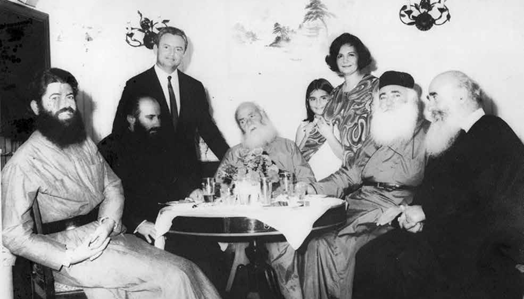Saint Gregory the Illuminator of Armenia
Saint Gregory lived and worked spiritually during the reign of the Emperor Diocletian (around 290 AD). His father was Anak the Parthian, who came from a noble family since he was a relative of the King of Armenia, Cusaros. Anak killed Kusaros with treachery and as a consequence of his act came the murder of his entire family. Only Gregory and one of his brothers escaped and fled to a region where Rome was sovereign. In Caesarea, Cappadocia, Gregory acquired both a Christian education and a Thyrian education. There he met and became acquainted with the son of Cusaro Tiridates, whom the Romans appointed – in place of his murdered father – king of Armenia. When he assumed his new duties, Tiridates called Gregory to him and began to press him unbearably to deny Christianity and embrace his religion. But Gregory was unmoved and firm. His faith was so deeply rooted in him that he could evangelize an entire people, which he did. Perhaps it was Gregory’s faith and example that St. Chrysostom had in mind when he emphasized that:“It is enough for aman to be zealous, to be zealous, to reform the whole city“. Gregory’s firmness angered King Tiridates and, forgetting his noble lineage, he immediately ordered terrible torture. What did his body not suffer? Dozens of ways of martyrdom endured by the Saint are mentioned in St. Nicodemus’ Synaxis. He was hung upside down on a stake and beaten with hatred, his ribs were torn apart with iron nails, boiled lead was poured into his body, and much more. And after all that, in order that he might have a certain but martyr’s death, they threw him into a deep pit with snakes and other reptiles. But the animals respected his suffering, took pity on the man, and obeyed the divine command to leave him intact, for God’s plan for his servant and for the people of Armenia was not yet complete. For years the confessor Gregory remained imprisoned in the drying house, living on a minimal amount of bread secretly thrown to him by a widow. Meanwhile, Tiridates went mad, ate his flesh, and rode with his pigs. His sister saw in a dream that only Gregory could make him well. And so it was. The impotent saint cured his tormentor and would-be murderer. After these events Gregory, with the consent and prompting of Tiridates, was consecrated bishop of Armenia and baptized the king and all the people in the Euphrates River. He ordained bishops himself, preached by his life and sufferings making himself a living relic, and departed to the high mountains of Armenia to continue his missionary work by praying and practicing for his flock unceasingly.

Saint Gregory, a model of missionary work
In order to become an enlightener of Armenia, Gregory went through two basic stages of spiritual experience necessary for missionary work:
- The confession of faith. It is fundamental to know, first of all, my faith, to know what Christ and His Church stand for, to know and accept that Christ is the Truth, Christ is the Life, Christ is the only true God and His Orthodox Church is the only, holy, catholic and apostolic Church.
- “Be clean first, see first, then be clean.” The Illuminator of the Armenians with his life and his apostolic ministry proved that the saying of Saint Gregory the Theologian is applicable. He endured myriad tortures and experienced the ascetic life in the pit of snakes for fifteen consecutive years. There he knew and experienced God, which is revealed by the miraculous healing of the king. A prerequisite, therefore, for the great work of spreading the Gospel throughout the world is spiritual preparation.
Finally, many believe that missionary work is only done by the people in the place of ministry. No. They are doing missionary work:
- those who love it,
- those who preach it from door to door,
- those who interrupt it in any way from our country,
- especially those who pray for it,
- everyone whose heart loves the work of mission to the nations, wherever he or she may be, from the bed of suffering to family life, from the daily life of school and work to the life of a pensioner.
Our Church celebrates the memory of the great confessor and missionary on 30 September.




